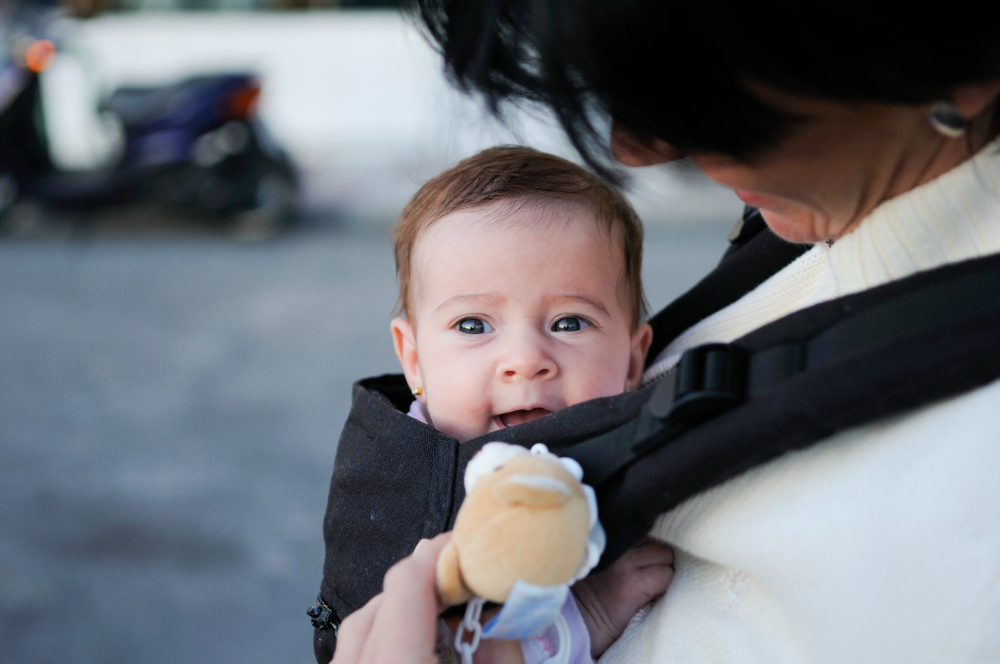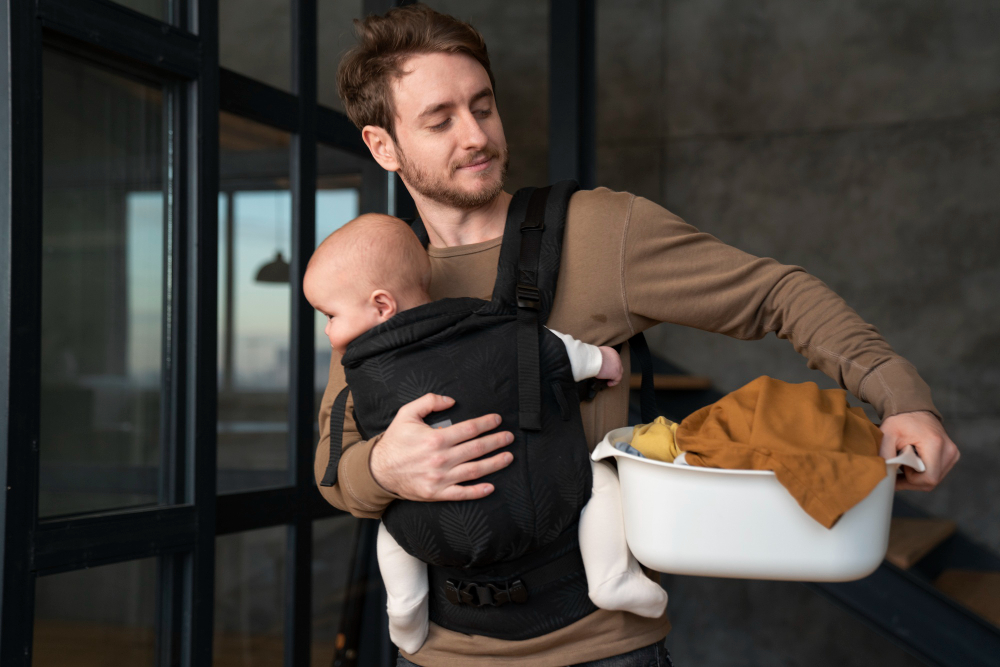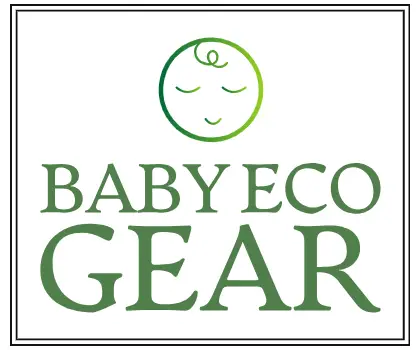Unlocking the Joys: Exploring the Numerous Benefits of Babywearing and Mastering the Art of How to Babywear a Newborn. As a devoted parent, your quest for comforting your baby, fostering a strong connection, and reclaiming your hands for daily tasks may find a perfect solution in the ancient tradition of babywearing. This timeless practice entails cradling your little one snugly against your body using a specially crafted carrier, providing a plethora of advantages that transcend mere convenience.
7 Powerful Benefits of Babywearing
Babywearing isn’t just a trend; it’s a practice backed by science and countless positive experiences. Here are 7 compelling reasons to consider incorporating babywearing into your parenting routine:
1. Foster Unbreakable Bonds
The constant physical contact and gentle movement of babywearing stimulate the release of oxytocin, a hormone known as the “love hormone.” This surge of oxytocin strengthens the bond between you and your baby, promoting feelings of security, attachment, and trust. This close connection can provide comfort and reassurance to your little one, especially during challenging transitions or unfamiliar situations.
2. Soothe Fussy Cries and Reduce Stress
The womb-like environment created by a carrier mimics the familiar sensations your baby experienced before birth. The rhythmic movement of your body, the warmth of your touch, and the gentle pressure of the carrier can all contribute to calming fussy cries and promoting relaxation in your baby. This can be especially helpful during periods of developmental leaps, growth spurts, or teething discomfort.
3. Free Your Hands for Everyday Tasks

No longer are you confined to holding your baby while you’re trying to get things done. Babywearing allows you to multitask with ease, whether you’re folding laundry, cooking dinner, or simply enjoying a cup of coffee. This newfound freedom allows you to be more productive and engaged while still keeping your baby close and content.
4. Enhance Brain Development and Sensory Integration
The close proximity to your body provides your baby with constant stimulation, exposing them to your movements, sounds, and sights. This rich sensory experience can contribute to their cognitive development, motor skills, and overall brain health. Additionally, the upright position in most carriers promotes better head and neck control, which is crucial for early development.
5. Combat Flat Head Syndrome (Plagiocephaly)
By providing proper head and neck support, babywearing can help prevent flat head syndrome, a common condition in infants. When used correctly, carriers ensure proper body alignment and distribute your baby’s weight evenly, minimizing pressure on the head and promoting healthy skull development.
6. Promote Better Digestion and Relieve Reflux
The upright position in most carriers helps improve your baby’s digestive system. This can be especially beneficial for babies with reflux, as the upright position helps prevent stomach acid from flowing back up and causing discomfort. Additionally, the gentle pressure of the carrier can provide a soothing sensation that can help ease tummy troubles.
7. Reduce Postpartum Depression and Support Emotional Well-being
The close contact facilitated by babywearing can help alleviate feelings of isolation and loneliness, which are common contributors to postpartum depression. The surge of oxytocin, the calming effect of your baby’s presence, and the sense of accomplishment from multitasking can all contribute to improved emotional well-being for parents.

FAQs: Your Questions Answered
With so many benefits to consider, it’s no wonder that babywearing is gaining immense popularity. However, some questions may arise before you embark on this rewarding journey. Here are some frequently asked questions and their answers:
1. When can I start babywearing?
The decision to begin babywearing is an exciting one, filled with the promise of bonding, convenience, and calming your little one. But when can you start this magical journey, and how do you choose the right carrier for your newborn?
The Early Start:
Rejoice, new parents! You can welcome your baby into the world of babywearing as early as the first few weeks after birth. This early introduction allows your little one to experience the familiar comfort of your touch and heartbeat, fostering strong bonds and promoting emotional well-being. However, choosing the right carrier and ensuring proper positioning are crucial for both safety and comfort.
Newborn-Friendly Carriers:
Not all carriers are created equal, especially for delicate newborns. Look for carriers specifically designed for infants, often labeled as “newborn-friendly.” These carriers offer:
- Adjustable head and neck support: This ensures proper alignment and prevents the chin from dropping onto the chest, which can obstruct breathing.
- Snug and supportive fit: The carrier should hug your baby close, providing a womb-like environment and distributing their weight evenly across your body.
- Comfortable leg position: Choose a carrier that allows your baby’s knees to be bent at a 90-degree angle, with their bottom supported in a deep squat position. This promotes healthy hip development and prevents pressure points.
Popular Options for Newborns:
Some popular choices for newborns include:
- Stretchy wraps: These offer a snug and customizable fit, perfect for mimicking the womb environment. However, mastering the wrapping technique takes practice.
- Soft-structured carriers (SSCs) with newborn inserts: These provide additional head and neck support, making them suitable for early babywearing. Look for SSCs with adjustable features and comfortable shoulder padding.
- Ring slings: These offer one-shoulder support and are ideal for quick feedings or short stints. However, they may not be as supportive for longer periods.
Remember, choosing the right carrier is about ensuring your baby’s safety and comfort. Don’t hesitate to consult with healthcare professionals or certified babywearing educators for guidance. They can help you find the perfect fit and provide valuable tips for safe and enjoyable babywearing from the very beginning.
The Importance of Proper Positioning:
Once you’ve chosen your carrier, ensuring proper positioning is essential. This involves:
- Maintaining an upright position: This allows for optimal breathing and prevents your baby’s chin from pressing against their chest.
- Checking for a clear airway: Your baby’s face should be clear and unobstructed at all times.
- Keeping your baby close: Your baby should be positioned high on your chest, close enough to kiss their head.
- Distributing weight evenly: Adjust the carrier’s straps and buckles to ensure your baby’s weight is evenly distributed across your body.
Start Slow and Enjoy the Journey:
Begin your babywearing experience with short bursts and gradually increase the duration as your baby gets comfortable. Pay close attention to their cues and take breaks as needed.
Remember, babywearing is a journey filled with joy, connection, and a multitude of benefits for both you and your little one. By choosing the right carrier, ensuring proper positioning, and starting slow, you can embark on this beautiful adventure and create lasting memories with your precious newborn.
2. What type of baby carrier is best?

With a diverse array of baby carriers available, selecting the right one can be overwhelming. Each type offers unique features and benefits, catering to specific needs and preferences. To help you navigate this selection process, here’s an overview of popular baby carrier options:
1. Wraps:
- Benefits: Stretchy and versatile, wraps offer a snug, womb-like experience for newborns. They are adjustable, allowing for a perfect fit for different body types and babies of various sizes.
- Drawbacks: Mastering the wrapping technique can take time and practice. They may feel warmer than other carriers, especially in hot weather.
- Best for: Newborns and infants, ideal for promoting bonding and kangaroo care.
2. Slings:
- Benefits: Easy to use and perfect for on-the-go moments. They offer one-shoulder support, making them ideal for quick feedings or short stints.
- Drawbacks: May offer less support than other carriers, especially for larger babies or long periods. Can cause shoulder discomfort for some wearers.
- Best for: Newborns and infants, good for short walks, breastfeeding, and quick outings.
3. Soft-structured carriers (SSCs):
- Benefits: Structured and supportive, offering optimal comfort for both baby and wearer. They come in various styles, designs, and adjustable features, accommodating different needs and ages.
- Drawbacks: Can be bulky and more expensive than other options. May require some adjustment to achieve the perfect fit.
- Best for: Infants and toddlers, suitable for longer walks, hikes, and outings.
4. Mei tais:
- Benefits: Combine the comfort of a wrap with the structure of an SSC. They offer a wide variety of positions and can be adjusted to accommodate different body types and baby sizes.
- Drawbacks: Learning to tie a mei tai can be challenging, requiring practice and assistance. May not be suitable for newborns due to the lack of head support.
- Best for: Infants and toddlers, ideal for parents who want a versatile and supportive carrier.
Choosing the Right Fit for You:
When selecting a baby carrier, consider your individual needs and preferences. Ask yourself:
- How often will I be using the carrier?
- What activities will I be doing while wearing the baby?
- What is my budget?
- What level of support do I need for my baby?
- Do I have any physical limitations that might affect how I carry the baby?
Once you’ve considered these factors, research different carrier options and try them on if possible. This will help you find the carrier that best suits your needs and ensures a comfortable and enjoyable experience for both you and your baby.
3. How do I know if my baby is comfortable?
Interpreting your baby’s comfort level is crucial for ensuring a positive and safe babywearing experience. Your little one will communicate their feelings through various cues, which you can learn to recognize and decipher. Here’s how to tell if your baby is comfortable in the carrier:
Positive Cues:
- Relaxed Body: Look for signs of relaxation like loose limbs, soft facial expressions, and peaceful breathing. A relaxed body language indicates your baby feels secure and content.
- Alertness: A happy and comfortable baby will be alert and curious about their surroundings. They may make eye contact with you, smile, and vocalize playfully.
- Sleeping: If your baby falls asleep in the carrier, it’s a good sign that they’re comfortable and relaxed. However, be mindful of their sleep position and ensure their airway is clear.
- Contentment: A contented baby will make soft sounds or coo, snuggle closer to you, and appear at ease. Their overall demeanor will reflect peace and satisfaction.
Negative Cues:
- Excessive Crying: Excessive crying or fussiness is a clear indication that your baby might be uncomfortable. Adjust the carrier’s position, check for any pressure points, and ensure their basic needs are met (hunger, diaper change, etc.).
- Stiff Body: A stiff body language with clenched fists and arched back suggests your baby might be feeling tense or uncomfortable. Adjust the carrier to ensure proper support and eliminate any tightness around their legs or chest.
- Turning Away: If your baby consistently turns their head away from you or tries to push themselves out of the carrier, it indicates they’re seeking a different position or want to be taken out.
- Facial Expressions: Watch for facial expressions like frowning, grimacing, or squinting. These can signify discomfort or pain, requiring you to adjust the carrier or take a break.
- Unusual Movements: Restlessness, fidgeting, or excessive kicking can be signs that your baby is trying to adjust themselves to a more comfortable position. Respond to their movements by adjusting the carrier accordingly.
Additional Tips:
- Observe your baby’s behavior regularly. Even subtle cues can provide valuable information about their comfort level.
- Respond to your baby’s cues promptly. Don’t wait for them to become distressed before taking action.
- Experiment with different positions. Some babies may prefer different positions in the carrier depending on their age and developmental stage.
- Allow your baby to communicate. Don’t force them to stay in the carrier if they’re clearly uncomfortable.
- Trust your instincts. You know your baby best, and your intuition often provides accurate signals about their comfort.
By observing your baby’s cues and responding promptly, you can ensure a comfortable and enjoyable babywearing experience for both of you. Remember, their well-being is paramount, and attentiveness to their needs will foster a positive bond and promote healthy development.
4. Are there any safety concerns with babywearing?

Absolutely, safety is paramount when it comes to babywearing. While it offers numerous benefits, it’s crucial to follow safe practices to minimize any risks. Here are some key points to remember:
1. Proper Fit:
Ensure the carrier fits snugly and securely. A loose carrier can be uncomfortable and increase the risk of falls.
Adjust the carrier according to your baby’s size and age. A carrier that’s too big or too small can offer inadequate support and compromise safety.
Pay particular attention to the leg position. Your baby’s knees should be bent at a 90-degree angle, with their bottom supported in a deep squat position. This promotes healthy hip development and prevents pressure points.
2. Head and Neck Support:
For babies under 4 months old, select a carrier that provides adequate head and neck support. This is crucial for their developing spinal cord and prevents the chin from dropping onto their chest, which can obstruct breathing.
Always keep your baby’s face clear and unobstructed. Ensure they can breathe easily and turn their head freely.
3. Close Supervision:
Never leave your baby unattended while wearing them in a carrier. Always maintain a close eye on them and be aware of their breathing and any signs of discomfort.
Avoid wearing your baby in a carrier while cooking, sleeping, or engaging in activities that could put them at risk.
4. Breathing Position:
Ensure your baby is positioned upright in the carrier. This allows for optimal breathing and prevents their chin from pressing against their chest, which can restrict airflow.
Avoid wearing your baby in a reclined position for extended periods, especially if they are under 4 months old.
5. Carrier Safety:
Inspect your carrier regularly for any signs of wear and tear, such as loose straps, ripped fabric, or broken buckles.
Never use a damaged or unsafe carrier, as it can put your baby at risk.
Follow the manufacturer’s instructions for safe use and cleaning of your carrier.
6. Comfort and Breaks:
Be mindful of your baby’s comfort level. Take regular breaks, especially during hot weather, to allow them to stretch their legs and move around freely.
Avoid wearing your baby for extended periods in a carrier, especially if they seem fussy or uncomfortable.
7. Seek Guidance:
If you’re unsure about the proper way to use your carrier or have any safety concerns, consult with a healthcare professional or certified babywearing educator. They can provide personalized guidance and ensure you’re using the carrier safely and effectively.
By following these safety guidelines and prioritizing your baby’s comfort and well-being, you can enjoy the numerous benefits of babywearing without any unnecessary risks. Remember, safety is always paramount, and a little vigilance can go a long way in ensuring your baby’s protected and thriving during your babywearing journey.
5. How Long Can I Babywear For?
The recommended babywearing duration varies depending on your baby’s age and development. Here’s a general guideline:
- Newborns (0-4 months): Aim for short bursts of 20-30 minutes at a time. Pay close attention to your baby’s cues and take breaks frequently. Ensure their head and neck are properly supported, and avoid placing them flat on their back.
- Infants (4-12 months): As your baby grows stronger, they can handle longer stretches of 1-2 hours in the carrier. Continue to monitor their comfort level and adjust the position as needed.
- Toddlers (12+ months): Older toddlers can enjoy extended periods of up to 3 hours in the carrier, depending on their individual preference and activity level. Encourage them to change positions and take breaks to stretch and move around.
Remember, these are just general recommendations. Always listen to your baby’s cues and adjust the duration accordingly. If you have any concerns, seek guidance from a healthcare professional or certified babywearing educator.
Additional Tips for Optimal Babywearing:
- Start slow and gradually increase the time spent in the carrier. This allows your baby to adjust and become comfortable with the experience.
- Choose a carrier that fits both you and your baby comfortably. Ensure it provides proper support and distributes your baby’sweight evenly.
- Pay attention to your baby’s position. Their knees should be bent at a 90-degree angle, with their bottom supported in a deep squat position. Their chin should be off their chest, allowing for clear breathing.
- Take regular breaks, especially during hot weather. Allow your baby to stretch their legs and move around freely.
- Be aware of your surroundings and avoid potential hazards while babywearing.
- Most importantly, enjoy the close connection and bonding experience that babywearing offers!
By following these tips and prioritizing safety, you can unlock the extraordinary benefits of babywearing for both you and your little one.
Conclusion: Embark on a Rewarding Journey with Babywearing
Babywearing is a beautiful and enriching experience for both parents and babies. It offers a wealth of benefits that go beyond convenience, fostering strong bonds, promoting healthy development, and enhancing emotional well-being. By embracing this practice and incorporating it into your daily routine, you can unlock a world of joy, connection, and growth for yourself and your little one. So, gather the courage, choose your carrier, and embark on this rewarding journey of babywearing!
